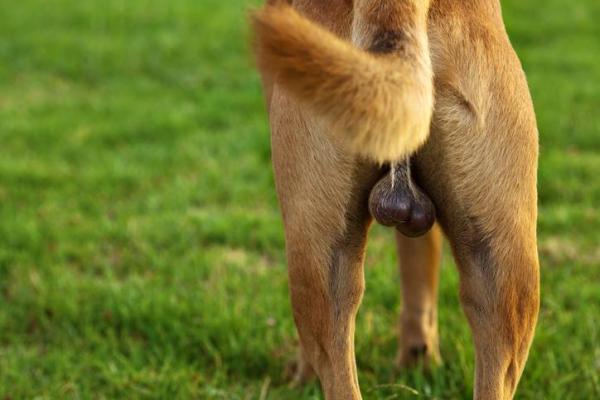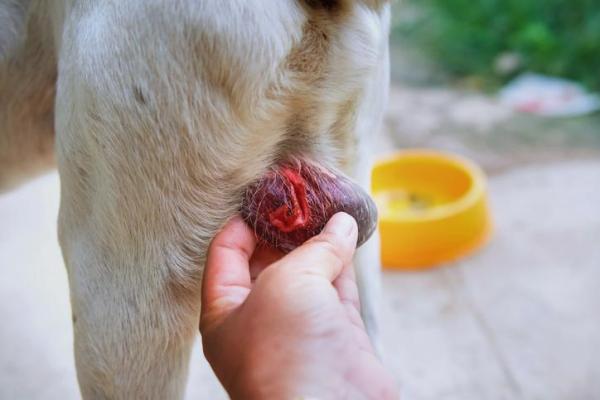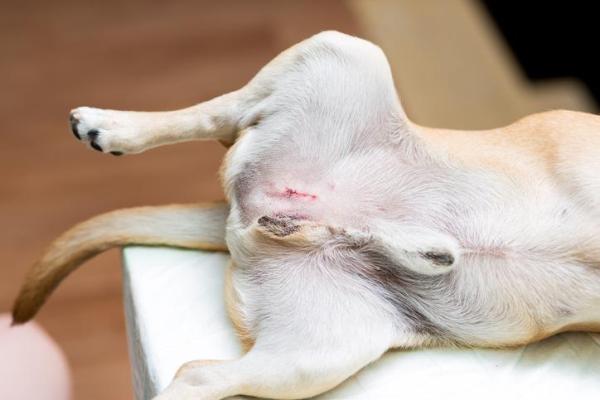
Testicles are one of the most sensitive areas on a dog's body. There are many opportunities where they can be injured, especially outside where there are many obstacles and unknown objects. This could be trauma due to contact with shrubbery or something else in their environment. It could also be irritation from sitting in a substance they shouldn't have. The problem doesn't always come from external sources, so we should be considerate of other possible pathological causes.
AnimalWised looks into why your dog has swollen testicles, suggesting possible causes of testicular inflammation in dogs and finding out if action needs to be taken. From the outset, we would like to stress the importance of sterilization for the benefit to your dog's general well-being and to prevent testicular problems specifically.
Anatomy of a male dog's genitals
Male dogs mature between the ages of 6 and 12 months, depending on the breed and other factors. In general, the larger the dog, the longer it will take for them to reach sexual maturity. The male canine reproductive system is comprised of the penis and the testicles, as well as the various ducts and tubes used to transport sperm and other fluids between them. The penis is covered by a prepuce, something equivocal to the human foreskin. The testicles are enclosed in the scrotum which should descend sometime around 2 months of age, but can often be delayed to around 6 months.
Both testicles should be firm, of a similar size, oval in shape and have regular consistency. The testicles should be housed in the scrotum. If they are not visible or you cannot feel them, they may still be inside the body. This could be due to a condition known as cryptorchidism, one of the most common genital defects in dogs[1]. This has various causes, but it will most likely mean the dog is sterile.
If only one of the testicles hasn't descended into the scrotum, this is known as monorchidism. These dogs are more likely to be fertile, so you will need to take precautions. If a dog's testicles have descended, but are particularly small in size, testicular hypoplasia may be present.
You may first be made aware of a possible problem in your dog's testicles when you see swelling or changes in color. You may wonder why are your dog's testicles red or even see lesions appear on their surface. Any change to the integrity of the dog's testicles needs to be understood. This is why we provide the main causes of testicular swelling in dogs.

Orchitis in dogs causes
If your dog's testicles have become swollen or enlarged it means they are exhibiting orchitis, the general term for testicular inflammation. We may also see canine epididymitis if the tube which allows sperm to enter (the epididymis) is swollen and the testicles swell as a result. These are symptoms of an underlying cause. The following are some of the most common causes of swollen dog testicles:
- Trauma: when bacteria enters a wound on the testicles, it can become infection and inflamed. Color changes may occur such as being red around the infection site or seeing purulent discharge. The cause of the wound is varied and could be trauma from hitting against something, the result of a fight with another dog or even a burn or frostbite. Even an ingrown hair can lead to testicular inflammation.
- Bloor or urine infection: the bacteria which causes infection doesn't necessarily have to enter externally. If the dog has a urine or blood infection, bacteria can enter the testicles and result in swelling.
- Contact dermatitis: as with any part of their external skin, if the dog's testicles come in contact with an irritant, it can result in swelling. This can be a plant toxic to dogs, a cleaning product or any other irritating substance which can result in inflammation.
- Atopic dermatitis: if the dog has a sensitivity to a particular allergen, they can have an allergic skin reaction which also causes swelling.
- Testicular torsion: as they hang down from the body, the dog's testicles are often vulnerable. If they get caught or twisted for any reason, it can result in testicular torsion whereby the connective tissue of the testicles is twisted to a harmful degree. It is relatively uncommon, but can result in orchitis or epididymitis.
- Viral or fungal infection: although less common than bacterial infections, it is possible that pathogens such as fungi or viruses can lead to testicular swelling.
- Parasites: if an external parasite bites or inserts themselves into the dog's scrotum, it can result in parasitosis. Testicular swelling is one possible symptom of this condition.
Infection will occur leading to inflamed and red testicles. From this initial infection, bacteria can travel to different parts of the body. In particular, it can spread through the spermatic cord. For this reason, it is very important we diagnose and treat the cause of a dog's swollen testicles as soon as possible
Symptoms of orchitis in dogs
If your dog has inflamed testicles due to orchitis, we will likely notice the area is also painful or sensitive. If the dog's testicles are swollen, they will usually lick the area frequently. The increase in size and associated pain will lead them to be uncomfortable. This means they may have trouble walking, sitting or lying down. You may notice that both testicles are inflamed, but it is most common for only one testicle to be enlarged. Both testicles may inflame as the infection spreads.

Treatment of orchitis in dogs
If we notice that our dog's testicles have become inflamed, you will need to take them to the veterinarian. Treatment will depend on the diagnosis, but if an infection is confirmed, the most likely treatment will be the administration of an antibiotic. This antibiotic will be specific to canines and a vet is needed to give the right prescription after assessment.
It may also be likely the vet will prescribe an anti-inflammatory to reduce the swelling and pain. A gauze soaked in cold water may be applied to provide some temporary relief, but our vet will need to assert this is helpful. An Elizabethan collar may be given to prevent the dog from accessing the testicles and exacerbating the situation.
Other treatment can include antiparasitic drugs if the cause is due to parasites, antihistamines can be administered when there is an allergic reaction and antifungal treatment may be required for fungal infections. Viral infections cannot be cured, but we can manage the symptoms with various drugs. If the problem is due to an allergic reaction, we need to ensure we do not allow the dog to come in contact with the allergen in the future.
For testicular torsion in dogs, surgical treatment is usually necessary. This will be required to stop the testicle necrotizing, as well as stop the pain for the dog. Often a full castration of both testicles will be carried out due to the additional benefits of neutering the dog.
Consequences of orchitis in dogs
If our dog has orchitis, it is possible that the testicle will decrease and harden after the inflammation has been adequately controlled. After this happens, it is unlikely sperm will be able to be produced. In some cases, the infection may have progressed to the stage that it cannot heal and the removal of the testicle is recommended (known as an orchiectomy).
Removal of the testicles is often performed preemptively as a means of sterilization. The benefits of this procedure have been recorded as reducing certain behavioral problems as well as reducing the likelihood of some diseases[2]. There are potential side effects, but it is generally accepted by the veterinary community to improve their state of well-being.

Testicular tumors in dogs
Testicular tumors in dogs are more prevalent in dogs with undescended testicles, being relatively rare in dogs with testicles which have descended. In these cases, we often see that the dog's testicles are larger than they should be, are of a harder consistency and feel irregular to the touch. Some tumors do not cause an increase in size, but will change the consistency of the testicle. Some may create the feeling of nodules over the testicle.
Certain canine tumors can produce estrogen, a type of female hormone which can lead to the dog displaying features more typical of female dogs. This is why a male dog with tumors on their testicles may have enlarged or swollen breasts. They may also have looser skin on their prepuce or lose hair in this area. The treatment for testicular tumors in dogs is usually surgery in the form of an orchiectomy. This is why it is so important any change to the testicles should be reported to the vet.
This article is purely informative. AnimalWised does not have the authority to prescribe any veterinary treatment or create a diagnosis. We invite you to take your pet to the veterinarian if they are suffering from any condition or pain.
If you want to read similar articles to Why Does My Dog Have Swollen Testicles?, we recommend you visit our Reproductive system diseases category.
1. Moon, J. H., Yoo, D. Y., Jo, Y. K., Kim, G. A., Jung, H. Y., Choi, J. H., Hwang, I. K., & Jang, G. (2014). Unilateral cryptorchidism induces morphological changes of testes and hyperplasia of Sertoli cells in a dog. Laboratory animal research, 30(4), 185–189. https://doi.org/10.5625/lar.2014.30.4.185
https://www.ncbi.nlm.nih.gov/pmc/articles/PMC4306707/
2. Yates, D., Hayes, G., Heffernan, M., & Beynon, R. (2003). Incidence of cryptorchidism in dogs and cats. The Veterinary record, 152(16), 502–504. https://doi.org/10.1136/vr.152.16.502
https://bvajournals.onlinelibrary.wiley.com/doi/abs/10.1136/vr.152.16.502